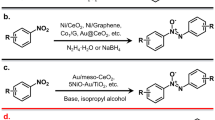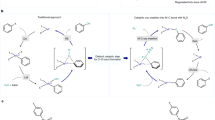Abstract
THE thermal dissociation of nitrous oxide has received considerable attention in the past in connexion with the collision theory of unimolecular and bimolecular reactions1, and it is known that oxygen atoms can be produced as a result of the primary dissociation N2O = N2 + O. This dissociation was considered to be the chain-initiating process in the H2—N2O reaction by Melville2, and in the CO—N2O reaction by Bawn3. In view of the production of atomic oxygen in the decomposition of nitrous oxide, some work has been carried out on the N2O—SO2 system in order to obtain some basic information on the association reaction SO2 + O = SO3, a process believed to be of some importance in relation to the oxidation of sulphur dioxide in flames4. This work will be reported in detail elsewhere ; but it is the purpose of this note to describe some observations on the nature of the luminescence accompanying the decomposition of nitrous oxide at temperatures of the order of 900° C., and the effect of various additions on this. Zeldovitsch and Jakovlev5 have studied briefly the explosive decomposition of nitrous oxide at high temperatures, and the appearance of yellow-green flashes in the combustion of carbon in nitrous oxide at 600–800° C. has been recorded by Shaw6 and Arthur7.
This is a preview of subscription content, access via your institution
Access options
Subscribe to this journal
Receive 51 print issues and online access
$199.00 per year
only $3.90 per issue
Buy this article
- Purchase on SpringerLink
- Instant access to full article PDF
Prices may be subject to local taxes which are calculated during checkout
Similar content being viewed by others
Change history
01 March 1947
An Erratum to this paper has been published: https://doi.org/10.1038/159299e0
References
Musgrave, F. F., and Hinshelwood, C. N., Proc. Roy. Soc., 135, 23 (1932); 137, 25 (1932).
Melville, H. W., Proc. Roy. Soc., 142, 524 (1933).
Bawn, C. E. H., Trans. Faraday Soc., 31, 461 (1935).
Dooley, A., and Whittingham, G., Trans. Faraday Soc., 42, 354 (1946).
Zeldovitsch, J. B., and Jakovlev, B. I., C.R. Acad. Sci., U.S.S.R., 19, 699 (1938).
Shaw, M. S., J. Chem. Soc., 2661 (1929).
Arthur, J. R., private correspondence.
Whittingham, G., Nature, 157, 550 (1946).
Gaydon, A. G., Proc. Roy. Soc., 183, 211 (1944).
Henriques, jun., F. C., Duncan, A. B. F., and Noyes, jun., W. A., J. Chem. Phys., 6, 518 (1938).
Author information
Authors and Affiliations
Rights and permissions
About this article
Cite this article
WHITTINGHAM, G. Luminescent Decomposition of Nitrous Oxide. Nature 159, 232 (1947). https://doi.org/10.1038/159232a0
Issue date:
DOI: https://doi.org/10.1038/159232a0
This article is cited by
-
Nitrogen and air afterglows: A survey
Journal of Applied Spectroscopy (1966)



